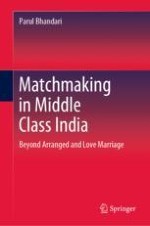2020 | OriginalPaper | Buchkapitel
3. The Modern Family
verfasst von : Parul Bhandari
Erschienen in: Matchmaking in Middle Class India
Verlag: Springer Singapore
Aktivieren Sie unsere intelligente Suche, um passende Fachinhalte oder Patente zu finden.
Wählen Sie Textabschnitte aus um mit Künstlicher Intelligenz passenden Patente zu finden. powered by
Markieren Sie Textabschnitte, um KI-gestützt weitere passende Inhalte zu finden. powered by
